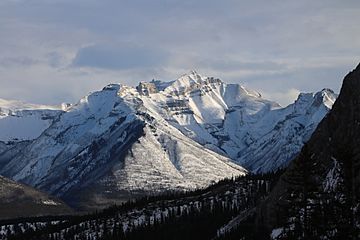Mount Peechee facts for kids
Quick facts for kids Mount Peechee |
|
|---|---|
 |
|
| Highest point | |
| Elevation | 2,935 m (9,629 ft) |
| Prominence | 160 m (520 ft) |
| Listing | List of mountains of Alberta |
| Geography | |
| Parent range | Fairholme Range |
| Topo map | NTS 82O/03 |
| Climbing | |
| First ascent | 1929 |
| Easiest route | rock climb |
Mount Peechee is a tall peak found in Banff National Park in Alberta, Canada. It's the third highest peak in the Fairholme Range. You can find Mount Peechee just southeast of Mount Girouard, in the Bow River valley, south of Lake Minnewanka.
The mountain got its name in 1884 from George Mercer Dawson. He named it after an Indigenous guide. This guide helped George Simpson travel through the front ranges of the Canadian Rockies.
Understanding Mount Peechee's Geology
Like other mountains in Banff Park, Mount Peechee is made of sedimentary rock. This type of rock forms from layers of sand, mud, and tiny bits of sea creatures that settle over millions of years. These layers were laid down during ancient times, from the Precambrian to the Jurassic periods.
Long ago, these rocks formed in shallow seas. Later, a huge event called the Laramide orogeny happened. This event caused the land to push up and fold. It pushed these older sedimentary rocks east, even over the top of younger rocks. This is how Mount Peechee and other mountains in the area were formed.
Mount Peechee's Climate and Weather
Mount Peechee is in a subarctic climate zone. This means it has very cold and snowy winters. The summers are usually mild. Temperatures can often drop below −20 °C (which is −4 °F). With the wind chill, it can feel even colder, sometimes below −30 °C (−22 °F).
All the rain and melting snow from Mount Peechee flows into small streams. These streams are called runoff. They eventually join the Bow River. The Bow River is a major river that flows into the larger Saskatchewan River.



